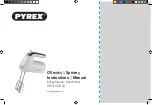
60
Chapter 6—Pan, Routing & Surround Pan
03D—Owner’s Manual
With both controls set at CENTER, as shown, the width of a stereo signal is
reduced to zero, and it’s fed to the buses in mono.
Setting the controls to positions in between these two extremes allows you
set the width of the stereo signal. To maintain a central balance, however,
you must set both controls to corresponding values. For example, L5 and
R5, or L10 and R10.
The stereo input channel and effects returns have balance controls. The bal-
ance control can be used to balance the levels of the left and right signals.
They does not affect the width of a stereo signal.
Including center, there are 33 pan and balance positions.
Pan Mode
The MODE switches, which are common to the Pan 1–16, Pan 17–24, and Bus to ST
pages, are used to set the pan mode for the stereo input channel, stereo effects returns,
and input channels that are configured as stereo pairs.
In this mode, pan controls can be adjusted individually.
In this mode, pan controls are ganged together.
In this mode, pan controls are ganged together but operation is inverted
(i.e., pan controls move in opposite directions).
Routing
A highlighted routing switch indicates that a channel is routed to a bus.
Input channels 1 to 16 have four bus routing switches (1, 2, 3, 4), a stereo rout-
ing switch (ST), and a direct out switch (D). See page 43 for information about
the direct output switch.
Input channels 17 to 24, the stereo input channel, and the effects returns have
four bus routing switches (1, 2, 3, 4) and one stereo routing switch (ST).
Routing switches are joined into one when bus outs are configured as stereo
pairs, as shown here. See Configuring Stereo Pairs on page 114 for more infor-
mation.
L16
←
L15
←
···
←
L2
←
L1
←
CENTER
→
R1
→
R2
→
···
→
R15
→
R16
Left
Center
Right
















































